Orchids’ natural habitats are typically found in tropical climates, cloud forests, and high-humidity areas with constant air circulation. Around 200 species of orchids grow in the United States, half of which are native to Florida.
The warmer tropical climate is favorable for many orchids to thrive. The humid summer can support orchids with minimal intervention. However, in winter, excessive heating systems or heaters cause the loss of humidity from the air, making it feel dry. Therefore, I have to manage conditions when using excessive heating or air conditioning.
Following this blog, you’ll be able to dial in the right humidity, reduce watering stress, prevent leaf and root dehydration, and keep your orchids vibrant and healthy. Let’s start!
Table of Contents
What are the Humidity Requirements for Orchids?
Humidity is crucial for successfully growing orchids at home. The ideal humidity range for orchids is between 40% and 70%. Anything more or less than this value is not beneficial for orchids’ health.
Proper humidity for orchids helps in healthy roots, allows leaves to expand more fully, and helps in bud formation and flower opening. Although orchids are moisture lovers, there is a slight difference between moisture in the air and being soaked in moisture, so avoid frequent misting on the plants.
Like all living things, orchids also breathe through a unique structure called stomata. During this process, they lose water vapor and oxygen and absorb carbon dioxide. Plants’ roots absorb water and lose water through leaves by the method of evapotranspiration.
At the same time, the average level of humidity in their surroundings will compensate for this loss, balancing the overall process. However, when the amount of water loss is greater than the water absorbed by the roots, the stomata close and inhibit the absorption of carbon dioxide.
Generally, the humidity preferences of orchids vary with orchid types. Paphiopedilum, Australian dendrobiums, cymbidiums, and Miltonia require lower humidity, as much as 40%. On the other hand, Vanda, Phalaenopsis, and Cattleya require high humidity, around 50-65%, with good air ventilation. Frequently check the humidity levels and adjust them according to the orchids’ preferences.
How to Measure Humidity?
ThermoPro TP55 Indoor Hygrometer
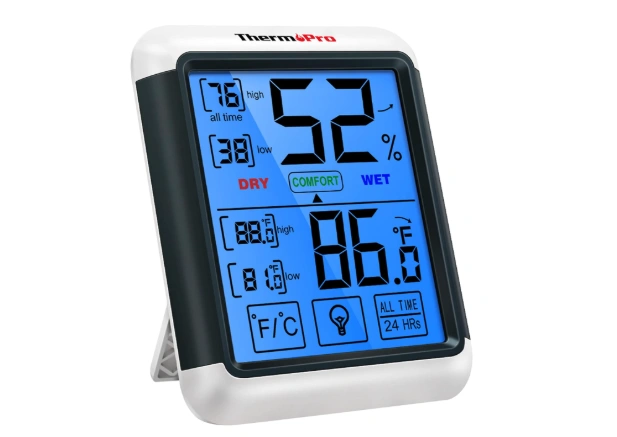
I use a digital hygrometer by ThermoPro to track the temperature and humidity of my plants. It is compact, simple to understand, and works great. I really like that this hygrometer frequently updates and provides real-time data. You can change it to Fahrenheit or Celsius, according to your preference.
This gadget has an advanced humidity sensor that gives reliable readings. It comes with a battery, but I would like it more if they gave a rechargeable option. But that’s the only limitation it has.
The touch screen displays large numbers, making it convenient to read without glasses. Moreover, you can install it in versatile ways as it comes with a stand to sit on the table, a magnet, and a wall mounting option.
An adequate humidity level plays a crucial role in the vigor, growth, and development of orchids. In low humidity levels, orchid roots and leaves wither, buds become deformed, and they seem wrinkled instead of plump. Your orchid won’t die due to low humidity, but dry orchids will exhibit blooming issues later on.
On the other hand, stress signs occur due to high humidity, such as leaf spotting, browning leaves, root rot due to bacterial and fungal growth, and bulb shriveling. For this purpose, install a hygrometer near the plants to monitor the humidity levels. Invest in it to cultivate healthy, stress-free orchids.
Outdoor Humidity Management
During seasonal shifts, pay extra attention to watering regimes, temperature, and sunlight. When conditions deviate significantly from the normal range, multiple issues arise. It’s better to make preparations in time to prevent all these stress-related conditions.
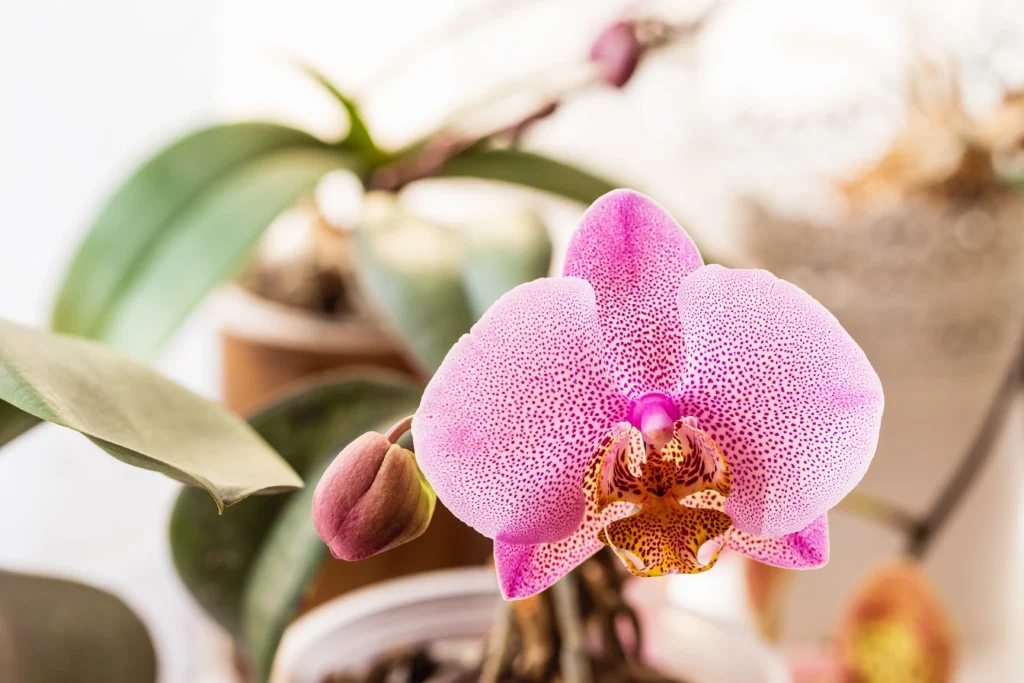
1. Relocate During Heat Waves
Orchids, especially Pleurothallids, Phalaenopsis, Paphiopedilums, and Miltonias, cannot tolerate high temperatures and heat stress. Therefore, they should be relocated indoors during the summer. These conditions are not suitable for orchid roots and leaves. Also, prolonged exposure to bright sunlight can cause irreversible physical damage to orchids, including sunburn.
Move sensitive orchids indoors when temperatures exceed 90°F to avoid stress and dehydration.
2. Water in the Evening
During summer, the midday sun is intense, and constant wind and direct sunlight will rapidly evaporate the moisture from the orchid pots.
Therefore, I have observed that watering the orchids at night allows their roots to absorb more moisture during the cooler hours than during the daytime heat. Furthermore, on alternate days mist the orchids early in the morning so they stay hydrated. Ensure the water does not remain on the leaves, and the roots are not submerged in water for an extended period.
3. Evaporative Cooling
Evaporative cooling is a wonderful technique for increasing humidity during peak heat days. You can create this effect by spraying shade house walls and floors with water every three days. Even on the hottest days in Florida, evaporated water lowers temperatures by 5–10°F and naturally raises humidity from 25% to 40-45%.
It works great and is followed by orchid growers around the world as it creates favorable conditions for outdoor orchids. However, it is unsuitable for wood floors to be soaked in water.
4. Shade Structures
If your orchids are in partial shade during summer, I advise placing them in a fully shaded area.
A shade cloth or pergolas reduce direct sun exposure while maintaining humidity. They are helpful for protection against direct sunlight while allowing a balanced amount to reach the orchid.
5. Greenhouse Consideration
The greenhouse gets too hot during midday, so it’s better to know the angle of the sun’s rays and use a full shade cloth for additional protection. It will create a cooling effect and minimize the moisture loss.
Use a misting nozzle to increase humidity, or simply wet the growing area in the late afternoon to boost humidity. Keep the area ventilated with high humidity. Otherwise, pathogens can start growing in the greenhouse.
Indoor Humidity Management
Humidity management is complex, yet possible. For example, a pebble tray can be used for indoor plants, but it is not suitable for hanging plants. But be careful, and don’t end up soaking the orchid’s root in water. Let’s explore some other methods too.
1. Ultrasonic Humidifiers
In winters, there isn’t enough moisture in the air, and plants respond to dry conditions and reveal symptoms such as wrinkled leaves, roots, and deformed buds.
There are various humidifiers available to address this issue and increase humidity, but the ultrasonic Humidifiers are top of my recommendation list for several reasons.
They silently increase the humidity in the surrounding air, are low maintenance, and look modern compared to traditional humidifiers.
They work well to maintain a humidity level of 45-50% for most orchids, even when heating systems are used. However, I have observed that on cold nights, some droplets from humidifiers may settle in the spaces if there is no proper air circulation. Also, a constant high humidity promotes bacterial and fungal growth on the orchids, so it is completely fine to let the air dry for a few hours.
For orchids that prefer high humidity, such as Vandas, I recommend using directional humidifiers. You need to place the humidifier at a height or bench relative to the orchid to create a localized “cloud effect.” The vapors will be directed towards the areas that need 60-80% humidity. I usually turn off the humidifiers in the evening due to the highly humid nights in Florida.
AquaOasis Mist Humidifier
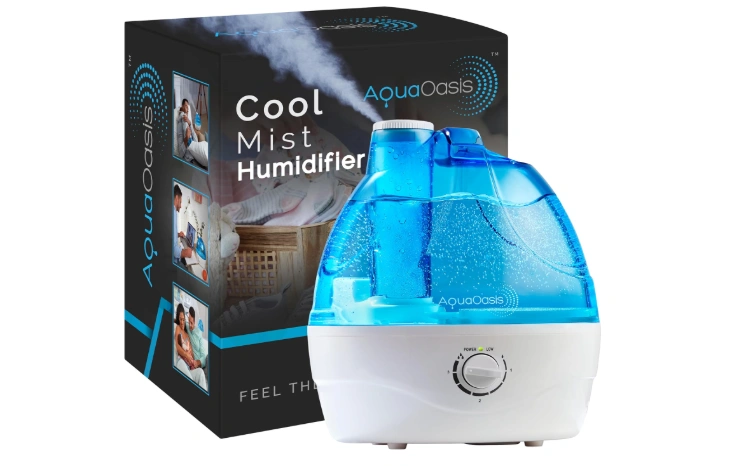
There are numerous products with ultrasonic systems, but I recently purchased the AquaOasis mist humidifier, and the results were beyond my expectations. It is worth the money and is excellent both in terms of functionality and appearance. It operates quietly without the background humming noise. Because of this feature, the noise does not disturb my daily activities.
I have seen a significant improvement in the humidity levels around my orchid collection. I like that it has different settings to adjust the mist. The large tank is enough to run the whole day and does not require a refill.
Moreover, when the water tank is empty, it turns off automatically, which is an advantage for people with goldfish memories (like me).
2. Humidity Trays
Humidity trays are very popular for growing orchids. They are lightweight and easy to clean. The tray holds water and is filled with gravel in some products. The water evaporates from the tray, raising the humidity by 5-15%.
Where They Work Best
Humidity trays provide a humid microclimate to orchids growing under lights or window sills. They work best for small, enclosed spaces, such as a plastic-covered shelf setup. Under the light, the water constantly evaporates, raising the humidity around the plants.
The watering regime makes a huge difference in maintaining humidity levels. I have noticed that freshly watered pots raise the humidity by 15% more than dry pots.
The tray works well for short orchids, such as paphiopedilums, as I have observed a 10% increase in humidity within six inches above the tray.
- Limitations: If you have already used a humidifier, then humidity trays are not something you would like. Although they do provide some moisture to orchids, they are not effective at raising overall humidity levels in large spaces.
Here are some of my recommendations in this regard.
Winco Trays
I have purchased the small ones for an event in my office. Later, I used them for my small orchids, and I was pretty surprised by their functionality. The trays work great for orchids growing under light. They keep the shelf clean, and I have observed a rise in humidity around more miniature orchids.
Humidi-Grow Trays
Humidi-Grow humidity trays are great for grouping plants. They’re simple to use and maintain a clean and neat space. I have used a few trays from other brands, but the common issue I faced was algae growth in the trays. This time, I purchased the right product, as it had been months, and the trays were clean.
These trays are perfect for small shelves. I place the Paphiopedilums above the tray and water normally. The extra water seeps down, and when it evaporates, it creates a humid effect for the orchids.
The material appears to be durable, so I hope it lasts a long time.
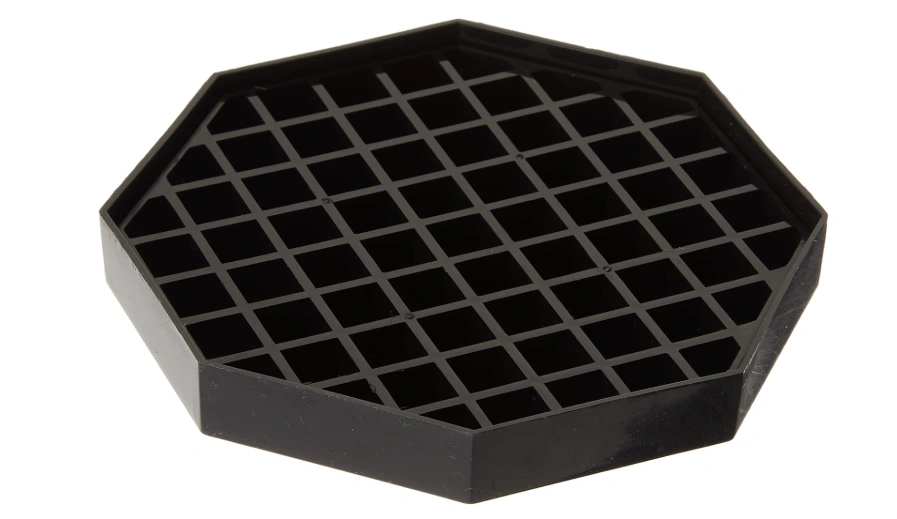
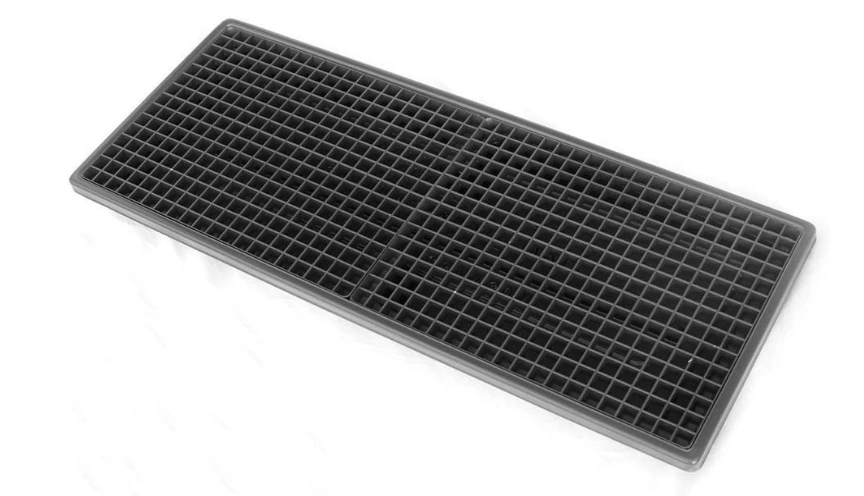
Wanna Make Your Own Humidity Tray?
Here’s a DIY hack for making it.
- Take a shallow tray large enough for the orchid and a few inches wider than the plant base.
- Fill the tray with aquarium gravel, pebbles, or small rocks.
- Add water to the tray so that the top of the pebbles is just slightly above the water level.
- Place the orchid in the tray. Make sure the orchids are not submerged in the water and only touch the dry pebbles.
- Clean the tray once a month and refill the water as needed.
3. Grouping Plants
Placing plants together, such as an extensive collection of orchids, releases moisture that increases local humidity and benefits everyone. This method works great for hydroponics pots, but never add excessive water to the pot to raise humidity. Orchid-preferred conditions are different from those of other houseplants, so it’s better to do your homework before mixing different plants with orchids.
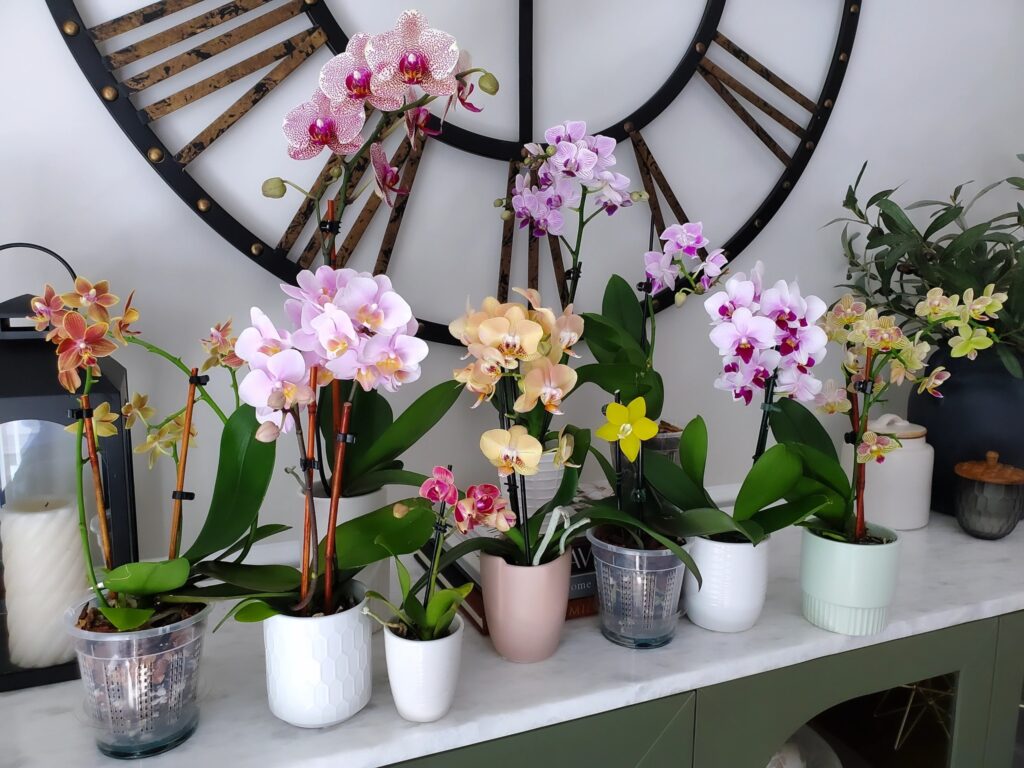
How to Care for Orchids in an Overly Humid Environment?
Orchids do need humidity, but not 100%. A relative humidity of 50% is enough for orchids. You can always tackle low-humidity conditions by investing in gadgets like humidifiers and humidity trays. However, an overly humid environment is detrimental to orchids, causing irreversible damage to plant health, including root rots, leaf spotting, and, in severe cases, plant death. Keep a record of the humidity range and maintain good ventilation around the orchids to avoid serious issues in the future.
Air Movement and Humidity Balance
As much as humidity is essential for the optimal growth of orchids, maintaining air movement is also crucial. Just like orchids, other creatures also prefer a moist, humid environment to thrive. I am talking about bacteria and fungi here. Both of them grow rapidly and are disastrous for orchids. Good air circulation around and between the orchids will prevent fungal growth, reduce leaf overheating, and promote healthy plant growth.
However, air movement should be adequate and gentle, so that the leaves sway slightly but not excessively. A strong wind in already low-humidity environments can reduce the moisture present in the air and dehydrate plants. Similarly, high humidity requires increased air circulation to prevent stagnant, moist conditions.
You can place the orchids near windows and doors or put them in front of fans for a couple of hours to improve air circulation.
Managing Cold Snaps
In areas where temperatures drop below 50°F at night:
- Temporary Protection:
- Use frost cloths or blankets to insulate outdoor orchids.
- Relocate sensitive species to a sheltered area like a garage or enclosed patio.
- Long-Term Solution: Invest in a small greenhouse to keep orchids warm during winter. Greenhouses can double as a year-round humidity control system.
Some Humidity-Related Facts and Misconceptions
Maintaining humidity for orchids is a challenging task and a topic of debate with mixed opinions. It raises many misconceptions, but I believe you can take safe steps without going overboard.
If you think spraying or misting plants helps, then you should continue doing it. But in my opinion, it does not significantly raise humidity. It only provides temporary moisture to the plant. Additionally, a common practice among orchid growers is to place ferns near orchids for houseplants to create a more humid microclimate, which is effective to some extent. But do not let them grow in the same pot, as they will significantly outgrow the orchids.
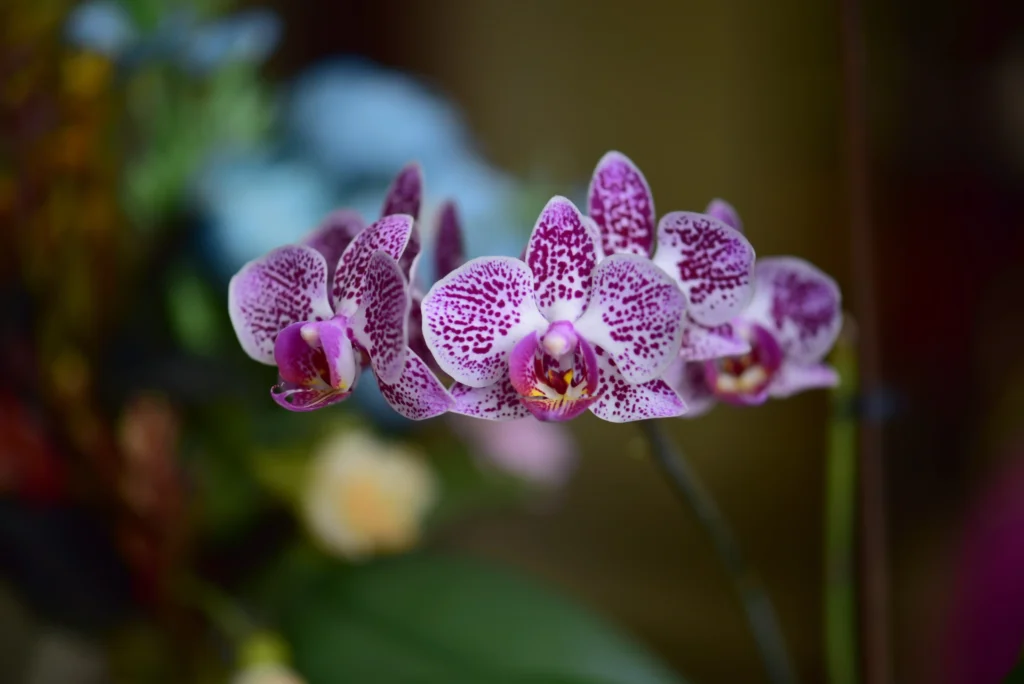
FAQs
Do orchids like bathroom humidity?
Orchids prefer a humid environment, but bathroom humidity is not recommended for orchids, as there is often poor air circulation around them.
Is misting suitable for orchids?
Frequent misting of orchids on warmer, drier days is beneficial for maintaining humidity temporarily. However, ensure that the water does not remain on the leaf crowns for an extended period.
Do humidity trays work for orchids?
Humidity trays are effective for small orchids growing in a closed space under a light. But if your goal is to increase the local humidity, I recommend investing in a humidifier.
What is the steam method for orchids?
The steam method for orchids is a technique that creates a natural, warm, and humid environment where orchids thrive. The moist conditions effectively promote root growth. However, I think you cannot compete with nature. The fresh breeze and damp conditions in a controlled greenhouse space cannot compete with the tropical climate. Therefore, it is better to grow the orchids in containers with other orchids and let them adapt in this way.
How do you keep mounted orchids moist?
It’s better to use an automated water system because mounted orchids require daily watering. Another effective method is soaking the greenhouse walls to prevent them from drying. In a humid environment, misting them occasionally is sufficient, but in a less humid environment, use trays and humidifiers.
Summing Up
Wrapping it up, keep your home’s humidity in the optimal ranges for your orchid varieties. It’s 50–70% for Phalaenopsis and Paphiopedilum, 40–60% for Cattleya, or 60–80% for humidity-loving Vanda.
It will transform your orchids from merely surviving to truly thriving. Simple tools like a high-output humidifier, strategically placed humidity trays, and grouping plants together can turn even the driest indoor air into a supportive environment.
Regularly monitor your levels, adjust as the seasons change, and balance moisture with good air circulation to prevent rot or mold.
Enjoy healthier roots, fuller pseudobulbs, and more abundant blooms. A proof that a little extra attention to air moisture goes a long way in orchid care.

